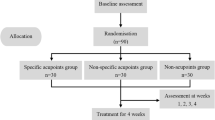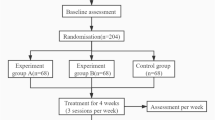Abstract
Objective
To observe the effect of electroacupuncture (EA) and herbal cake-partitioned moxibustion on anxiety and depression in patients with Crohn’s disease (CD) in remission.
Methods
Sixty CD cases were randomly allocated into an EA group (n=30) and an herbal cake-partitioned moxibustion group (n=30) using the random number table by the ratio of 1:1. In addition, 30 healthy subjects were included in a control group. Bilateral Tianshu (ST 25), Qihai (CV 6) and Zhongwan (CV 12) were used in the EA and herbal cakepartitioned moxibustion groups. The treatment was done 3 times a week, for a total of 12 weeks. The efficacy was evaluated using self-rating anxiety scale (SAS), self-rating depression scale (SDS) and traditional Chinese medicine (TCM) symptom scores.
Results
Before treatment, the SAS and SDS scores in CD patients were remarkably higher than those in healthy subjects. After EA or herbal cake-partitioned moxibustion treatment, the SAS and SDS scores were significantly decreased in both groups, showing significant intra-group differences (P<0.05); the symptom scores of abdominal pain (severity, frequency and duration), bowel sounds/flatus and general fatigue were significantly decreased, showing significant intra-group differences (P<0.05); however, there were no between-group statistical differences (P>0.05).
Conclusion
Both EA and herbal cake-partitioned moxibustion can significantly decrease abnormally high SAS and SDS scores in CD patients as well as TCM symptom scores. The two therapies share similar effects in alleviating common symptoms and improving anxiety and depression.
摘要
目的
观察电针和隔药灸对缓解期克罗恩病(Crohn’s disease, CD)患者焦虑和抑郁情绪的影响。
方法
将60 例符合纳入标准的患者按照1:1 比例按随机数字表随机分为电针组和隔药灸组, 纳入30 例健康受试者作对照。电针组或隔药灸组均选取双侧天枢, 气海和中脘, 电针组患者采用电针治疗, 隔药灸组患者采用隔药灸治疗, 每星期治疗3 次, 共治疗12 星期。以自评焦虑量表(self-rating anxiety scale, SAS)、自评抑郁量表(self-ratingdepression scale, SDS)及中医症状积分为观察指标进行疗效评价。
结果
与健康受试者相比, CD 患者SAS 和SDS评分显著增加。电针和隔药灸治疗后, 两组患者SAS 和SDS 评分均显著降低, 与本组治疗前有统计学差异(P<0.05); 患者腹痛(程度、频次、时间)及肠鸣矢气、神疲乏力症状积分显著降低, 与本组治疗前有统计学差异(P<0.05), 两种疗法间差异无统计学意义(P>0.05)。
结论
电针和隔药灸均能降低CD 患者异常增高的SAS、SDS 评分及常见中医症状积分, 在缓解临床常见症状的同时改善其焦虑和抑郁情绪, 两种疗法作用相当。
Similar content being viewed by others
References
Kalla R, VenthamNT, Satsangi J, Arnott ID. Crohn's disease. BMJ, 2014, 349: g6670.
Ananthakrishnan AN, Khalili H, Pan A, Higuchi LM, de Silva P, Richter JM, Fuchs CS, Chan AT. Association between depressive symptoms and incidence of Crohn's disease and ulcerative colitis: results from the nurses' health study. Clin Gastroenterol Hepatol, 2013, 11(1): 57–62.
Mawdsley JE, Rampton DS. Psychological stress in IBD: new insights into pathogenic and therapeutic implications. Gut, 2005, 54(10): 1481–1491.
Cámara RJ, Schoepfer AM, Pittet V, Begré S, von Känel R, Swiss Inflammatory Bowel Disease Cohort Study (SIBDCS) Group. Mood and nonmood components of perceived stress and exacerbation of Crohn's disease. Inflamm Bowel Dis, 2011, 17(11): 2358–2365.
Farrokhyar F, Marshall JK, Easterbrook B, Irvine EJ. Functional gastrointestinal disorders and mood disorders in patients with inactive inflammatory bowel disease: prevalence and impact on health. Inflamm Bowel Dis, 2006, 12(1): 38–46.
Kim ES, Cho KB, Park KS, Jang BI, Kim KO, Jeon SW, Jung MK, Kim EY, Yang CH, Daegukyungbook Gastrointestinal Study Group (DGSG). Predictive factors of impaired quality of life in Korean patients with inactive inflammatory bowel disease: association with functional gastrointestinal disorders and mood disorders. J Clin Gastroenterol, 2013, 47(4): e38–e44.
Addolorato G, Capristo E, Stefanini GF, Gasbarrini G. Inflammatory bowel disease: a study of the association between anxiety and depression, physical morbidity, and nutritional status. Scand J Gastroenterol, 1997, 32(10): 1013–1021.
Walker JR, Ediger JP, Graff LA, Greenfeld JM, Clara I, Lix L, Rawsthorne P, Miller N, Rogala L, McPhail CM, Bernstein CN. The Manitoba IBD cohort study: a population-based study of the prevalence of lifetime and 12-month anxiety and mood disorders. Am J Gastroenterol, 2008, 103(8): 1989–1997.
Bao CH, Zhao JM, Liu HR, Lu Y, Zhu YF, Shi Y, Weng ZJ, Feng H, Guan X, Li J, Chen WF, Wu LY, Jin XM, Dou CZ, Wu HG. Randomized controlled trial: moxibustion and acupuncture for the treatment of Crohn’s disease. World J Gastroenterol, 2014, 20(31): 11000–11011.
Bao CH, Wu LY, Wu HG, Shi Y, Liu HR, Zhang R, Yu LQ, Wang JH. Moxibustion inhibits apoptosis and tumor necrosis factor-alpha/tumor necrosis factor receptor 1 in the colonic epithelium of Crohn’s disease model rats. Dig Dis Sci, 2012, 57(9): 2286–2295.
Bao CH, Wu LY, Wu HG, Shi Y, Liu HR, Zhang R, Yu LQ, Wang JH. Moxibustion down-regulates the colonic epithelial cells apoptosis and repairs the tight junctions in rats with Crohn’s disease. World J Gastroenterol, 2011, 17(45): 4960–4970.
Zhao C, Bao CH, Li J, Zhu YF, Wang SY, Yang L, Shi Y, Liu HR, Dou CZ, Ding GH, Wang XM, Wu HG. Moxibustion and acupuncture ameliorates Crohn’s disease by regulating the balance between Th17 and Treg cells in the intestinal mucosa. Evid Based Complement Alternat Med, 2015: 938054.
Shang HX, Wang AQ, Bao CH, Wu HG, Chen WF, Wu LY, Ji R, Zhao JM, Shi Y. Moxibustion combined with acupuncture increases tight junction protein expression in Crohn's disease patients. World J Gastroenterol, 2015, 21(16): 4986–4996.
Shi Y, Bao CH, Wu HG, Chen WF, Qin XD, Zhang R, Wu LY. Effects of herbs-partitioned moxibustion on the expressions of intestinal mucosa TNF-a, TNFR1, TNFR2 and apoptosis of intestinal epithelial cells in Crohn’s disease patients. SH J TCM, 2010, 45(1): 46–50.
Shi Y, Bao CH, Wu HG, Ma XP, Yu LQ, Zhang R. Effect of moxibustion on colonic TNF-a content and influence of colonic supernatant of Crohn’s disease rats undergoing moxibustion on expression of occludin, caudin-1 and zonula occludens-1 proteins and genes in cultured colonic epithelial cells. Zhen Ci Yan Jiu, 2011, 36(4): 235–241.
Bao CH, Shi Y, Ma XP, Li G, Liu HR, Wu LY, Wu HG. Pathogenesis of Crohn’s disease: advances in its acupuncture-moxibustion treatment and thinking. Shanghai Zhenjiu Zazhi, 2010, 29(11): 681–686.
Working Group of Inflammatory Bowel Disease, Digestive Disease Branch, Chinese Medical Association. Consensus on diagnosis and treatment norms of inflammatory bowel disease in China. Chin J Intern Med, 2008, 47(1): 73–79.
Zung WW. A rating instrument for anxiety disorders. Psychosomatics, 1971, 12(6): 371–379.
Zung WW, Richards CB, Short MJ. Self-rating depression scale in an outpatient clinic: further validation of the SDS. Arch Gen Psychiatry, 1965, 13(6): 508–515.
Guo NF. National vocational qualification training course: psychological counselor (three degree). Beijing: Publishing House of Nationalities, 2005: 194–198.
Ministry of Health of the People’s Republic of China. Guiding Principles for Clinical Study of New Chinese Medicines. Beijing: China Medical Science Press, 2002: 132–134.
Dou CZ, Feng H, Zheng X, Liu XX, Zhu XF, Liu SM, Wu LY, Yang L, Lu Y, Zhang WW, Liu HR. Thinking on functional mechanism of acupuncture for inflammatory bowel diseases based on metabolomics. J Acupunct Tuina Sci, 2014, 12(2): 73–79.
An CP, Huang Y, Ma XP, Wu HG, Shi Z, Yang L, Dou CZ, Hong J. Effect of medicinal cake moxibustion on the expressions of colonic fibroblast CTGF, FN and Smad in Crohn disease rats. Shanghai Zhenjiu Zazhi, 2014, 33(6): 487–491.
Hong J, Zhang CH, Ma XP. Pathogenesis of inflammatory bowel disease and the action mechanism of moxibustion. J Acupunct Tuina Sci, 2012, 10(3): 174–180.
Luo R, Xie L, Jia B. Immunology mechanism Crohn’s disease cytokine and the research of traditional Chinese medicine. Zhonghua Zhongyiyao Xuekan, 2011, 29(6): 1213–1215.
Author information
Authors and Affiliations
Corresponding author
Rights and permissions
About this article
Cite this article
Bao, Ch., Zhang, Jz., Wu, Ly. et al. Effect of electroacupuncture and herbal cake-partitioned moxibustion on anxiety and depression in patients with crohn’s disease in remission. J. Acupunct. Tuina. Sci. 14, 87–92 (2016). https://doi.org/10.1007/s11726-016-0906-6
Received:
Accepted:
Published:
Issue Date:
DOI: https://doi.org/10.1007/s11726-016-0906-6
Keywords
- Acupuncture Therapy
- Electroacupuncture
- Moxibustion Therapy
- Indirect Moxiubustion
- Acupuncturemoxibustion Therapy
- Crohn Disease
- Depression
- Anxiety




